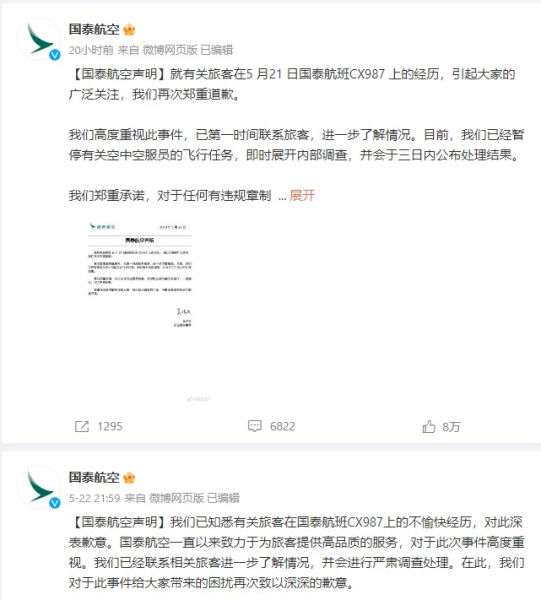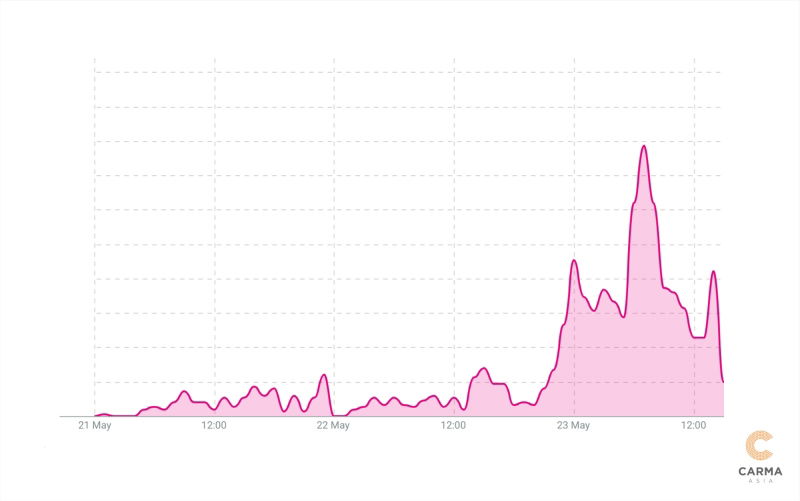
Cathay Pacific's apology and firing of cabin crew members: Will it be enough to weather the PR storm?
share on
Last night, Cathay Pacific apologised and announced the firing of three cabin crew members who were accused by a passenger of insulting and discriminating against non-English speakers.
According to an official statement sent to MARKETING-INTERACTIVE on 23 May, Cathay’s CEO Ronald Lam apologised on behalf of the company to the concerned customer and the community regarding the incident. He said after conclusion of the internal investigation, “we have terminated three cabin crew members who were involved in accordance with the company’s policies,” the statement read.
Lam reiterated the company’s zero-tolerance approach to any serious breach of the company’s policies and code of conduct and there is no compromise for such violations. “To avoid any similar occurrences in the future, I will personally lead a cross-departmental taskforce to conduct a comprehensive review into our service flow, people training and relevant mechanisms to further enhance Cathay Pacific’s service quality,” the statement added.
"Importantly, we need to ensure that all Cathay Pacific employees must at all times respect customers from different backgrounds and cultures, and that we provide quality services consistently across all markets that we serve," Lam added.

This comes after details of the alleged incident during a flight from Chengdu in Sichuan province to Hong Kong on Sunday revealed on Xiaohongshu went viral across social platforms. The Xiaohongshu user made several accusations against some cabin crew members on the flight CX987, including some members teased passengers’ language ability by saying in English: “If you cannot speak ‘blanket’, you cannot have it,”, “Carpet is on the floor”. The post has garnered over 10k likes and 1,000 comments. Since then, Cathay apologised twice on Weibo on 22 and 23 May respectively, stating that it has suspended the flight attendants involved during the course of an internal investigation.

Negative sentiments surged overnight
The incident has drawn over 30,000 mentions globally related to the incident as of 23 May, with 53.1% of them being negative, according to media intelligence firm CARMA. “Prior to the incident, Cathay enjoyed an 18.2% positive sentiment on social media. However, the incident has had a significant impact on brand sentiment, with a shift towards negative sentiment, which now stands at 22.9%, while positive sentiment is only at 7.2%,” said CARMA’s HK GM Charles Cheung.
It's worth noting that the volume of mentions is on an upward trend, with more netizens taking to different platforms to express their views, said Cheung.
He added:
This suggests that the PR crisis is far from over, and Cathay Pacific will need to take further action to address the concerns and win back the trust of its customers.

How can Cathay rebuild its brand image in the long run?
Cathay’s swift response of apologising and firing the employees involved is perhaps commendable as it looks to put out the fire from angry passengers and netizens. However, industry players MARKETING-INTERACTIVE spoke to agreed that the airline needs to look deeper beyond putting a bandage on the issue, to rebuild its brand image in the long run.
On the PR front, Jose Raymond, director of strategic advisory, PRecious Communications said given that the CEO has himself apologised for the misdeeds of the crew members, it should do well to assuage the unhappiness which transpired following the release of the audio clip.
One obvious next step for Cathay would be for itself to reinforce its non-discrimination policy across its teams, so that staff will remember the values the brand stands for, he said.
While the immediate action by the CEO may be right, it cannot stop with the apology and the firing, said a PR professional with more than 25 years experience, who wished to stay anonymous.
“There needs to be a thorough investigation as to whether the incident involved only three errant staff, or whether it is endemic in the culture of the cabin crew, and whether training of the staff has been trained properly, or whether ongoing engagement with cabin crew is robust enough,” the PR professional added.
Further agreeing with the PR professional was David Ko, managing director of RFI Asia, who said Cathay did the right thing by firing staff that do not live up to their service standards, but rebuilding Cathay’s brand's image after an incident requires a genuine commitment to improving internal policies and practices, said Ko.
He added:
The next thing they should do is review their internal policies regarding employee behaviour and install a zero-tolerance attitude for racial discrimination, including towards mainland Chinese passengers who routinely suffer discrimination in Hong Kong.
This might include diversity and inclusion training, and optimising the hiring process to weed out bigotry, he said.
The airlines should also address the underlying issues of discrimination from their staff, said Charu Srivastava, chief strategy officer and corporate affairs lead of TriOn & Co. "Perhaps a proper audit of its culture with a clear focus on diversity. If there are policies and processes that clearly address and guide the company’s stand toward inclusion and diversity, they should consider making these public," she added.
A former PR professional who wished to stay anonymous said in the long term, Cathay could take several measures to rebuild its reputation, including highlight the diversity and inclusion initiatives of CX through social media, reviewing training programmes for cabin crew members to promote awareness and understanding of different cultures, languages, and customs.
Another area worth noting is that with the increased popularity in usage in social media, a PR crisis can be amplified with everyone being an influencer or critic, said Desmond Ku, founder and director of The Bridge Agency. “We need to be careful of how we act as we are being closely watched on social media, if something goes wrong people can complain by exposing everything online.” Overall, Ku believed the better way to rebuild Cathay’s brand image in the long run is to start with staff training.
Related articles:
Cathay Pacific's new brand campaign encourages passengers to 'get themselves moving'
Cathay Pacific dives deep into sustainability with creative woodcraft collection
Join Content 360 - Hong Kong: Stories For A New Era where over 150 content marketers come together to shape the future. Content 360 - Hong Kong is a must-attend conference that focuses on cutting-edge content trends, innovative creation techniques, strategies to customise your content for the newest marketing channels, and more. Don't miss out on this opportunity to elevate your content marketing game in Hong Kong! Tickets are on sale now, register today. https://conferences.marketing-interactive.com/content360-hk/
share on
Free newsletter
Get the daily lowdown on Asia's top marketing stories.
We break down the big and messy topics of the day so you're updated on the most important developments in Asia's marketing development – for free.
subscribe now open in new window
